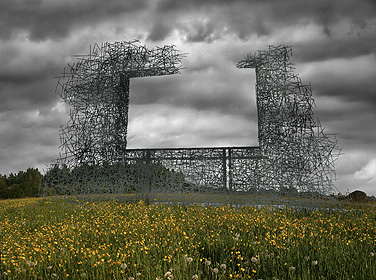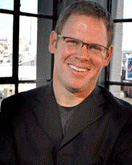News
Social consciousness underscores
Architecture and Planning lecture series

“Non-Sign II” from Annie Han’s Lead Pencil Studio
-
 Print
Print -
 Comments
Comments
-

John Peterson will discuss “Nonprofit Practice and Socially Active Research” on Oct. 5.
This fall, the Architecture and Planning Lecture Series will bring widely recognized architects and planners to town to explore issues like environmental sustainability and, in a broad sense, their social responsibility to the larger community.
All talks are free of charge and open to the public. They all will take place at 5:30 p.m. on the dates cited in 301 Crosby Hall, South Campus.
The series includes an emphasis on such issues as architecture, globalization and climate change, as represented by architect and McHale fellow Philippe Rahm, whose talk is funded by the Martell Distinguished Critic Endowment, and farmland preservation and water use, represented by the work of noted planner Tom Daniels, this year's Clarkson Chair in Planning.
Also speaking will be John Peterson, the award-winning founder of Public Architecture; pioneering architect/artist Annie Han, co-founder of Lead Pencil Studios; and Mabel O. Wilson, who has made her mark in the fields of architecture, visual cultural analysis and cultural history.
John Peterson, who will speak on Oct. 5, will discuss “Nonprofit Practice and Socially Active Research.” He is the award-winning founder and president of Public Architecture, which puts architectural resources to work in service to the public interest.
He also is principal of Peterson Architects, San Francisco, which has produced a great deal of pro bono work for art institutions, city agencies, community development corporations, social service agencies and other nonprofit organizations. He is a member of the San Francisco Green Vision Council and Open Space Task Force, and has received many citations from the AIA including its 2009 Designer of the Year Award with former Public Architecture Executive Director John Cary.
Philippe Rahm, who will deliver the McHale Lecture, “Environment and Technology Research” on Oct. 12, is principal in Philippe Rahm architects, based in Paris. His work is said to “extend the field of architecture from the physiological to the meteorological” perhaps because he studies the implications of climate conditions for architectural spaces and is internationally recognized for his sustainability ethos. Rahm addresses such issues as energy consumption and natural resources, limiting humanity’s control of the environment, the search for renewable resources and the optimal means to employ them.
He represented Switzerland in the 8th Architectural Venice Biennale in 2009 amd was nominated for China’s Ordos Prize in 2010 and for Russia’s International Chernikhov Prize in 2008. He has taught at major architectural institutions in Denmark, Switzerland and Norway and begins teaching at Princeton University this semester. His work has been exhibited widely in distinguished venues in Canada, the U.S. and Europe.
The McHale Fellowship was endowed in 2000 by Magda Cordell McHale to support design work that involves speculation on the impact of new technologies on architecture. A member of the UB architecture faculty from 1978 to 1999, McHale was a founding member, with her husband John McHale, of Britain's pioneering and very influential Independent Group.
The Martell Distinguished Critic Endowment, which is funding Rahm’s talk, was founded by the Martell Endowment in 2005 with a gift from Christopher Michael Martell, who holds a bachelor’s degree and a master’s degree from the UB School of Architecture and Planning, and his wife, Sally. The endowment supports a program to bring architects of international significance to the school to work with graduate students and present an annual school-wide lecture.
Tom Daniels, the Clarkson Chair in Planning, will speak on Nov. 1. He is professor of city and regional planning at the University of Pennsylvania, where he directs the concentration in land-use environmental planning. His principle areas of interest are farmland preservation, growth management and the connection between land use and water quality. He has served a consultant to state and local governments and land trusts, and for nine years managed the nationally recognized Lancaster County, Pa., farmland preservation program. He is the author of several books about managing growth, including the “Small Town Planning Handbook” (2007) and “The Environmental Planning Handbook” published by the American Planning Association.
The Clarkson Visiting Chair is a visiting position endowed by Will and Nan Clarkson. It is awarded to distinguished scholars or professionals in the disciplines of architecture and urban planning to recognize excellence in the pursuit of scholarship and professional application within these disciplines.
“Design Research” will be the topic of a Nov. 2 talk by Annie Han. Han and Daniel Mihalyo, her partner in the Seattle-based architecture and installation firm Lead Pencil Studio, are professional architects and artists who use unconventional architectural systems and new media to explore issues of spatial perception. The surprising and arresting spaces, objects and buildings they have produced have garnered international attention. They won the 2008-09 Prix de Rome from the American Academy in Rome and the 2009-10 New York Prize from Van Alen Institute. Their massive, ghostlike construction “Maryhill Double” was named one of the 25 greatest works of art ever made in Seattle.
The series will close for the semester with a Nov. 16 talk on “Race, Society and Architectural Research” by Mabel O. Wilson, an award-winning designer and scholar. Wilson is associate professor in the Columbia University Graduate School of Architecture, Planning and Preservation, where she directs the program for advanced architectural research. She also heads the Historically Black Colleges and Universities Design Leadership Project.
Her multidisciplinary practice involves the fields of architecture, visual cultural analysis and cultural history, and her collaborative design practices KW and Studio 6Ten have produced speculative and built projects that have been shown at a number of national and international venues.
Her practice has been a competition finalist for several important cultural institutions, including lower Manhattan’s African Burial Ground Memorial and the Smithsonian’s National Museum for African American History and Culture (with Diller Scofidio +Renfro). Her essays have been published in many journals and in books on critical geography, cultural memory, art and architecture. She is working on a book, “Progress and Prospects—Black Americans and the World of Fairs and Museums.”

Reader Comments